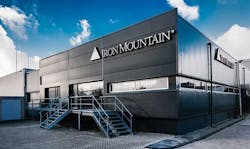New users, technologies, devices and apps are keeping data growth levels very high year on year. At the same time the rise and rise of mobile, increases in mobile processing power, power and planning pressures, M2M and IoT are spreading demand for data centers more evenly across European markets.
Last year was unbelievable in terms of data center demand levels across EMEA. Looking at the Q4 CBRE report, take-up in the FLAPD markets (Frankfurt, London, Amsterdam, Paris and Dublin) was 384 MW. That feels about right, and reflects the sort of year we had at Iron Mountain Data Centers. Following what felt like an ‘everything must go’ buying frenzy in Frankfurt, we had to revise targets upwards significantly in the first part of the year, yet we still exceeded the new targets. According to the CBRE report, the last quarter was particularly active across all markets, with half of the new 2022 space delivered as well as half of the year’s take-up. Supply was racing hard to keep ahead of demand, and you could see this in the exceptionally low vacancy levels.
More importantly, the growth arrow looks set to continue on the same trajectory, with a forecast take-up of 440 MW for this year - that’s a very strong 14.6% growth line. And there is confidence that supply will accelerate to meet and comfortably exceed that, with a total supply figure of 572 MW.
In other words we are lucky to be in a very healthy and robust market where supply is flexible enough to exceed rising demand. But there are a few issues I think are worth looking at with a view to the medium and longer term. One is around the primary source of that demand, the hyperscale cloud businesses, and its potential to impact customer mix. And the other is around shifts in data center design and market geography.
Maintaining the Mix
First, the relationship between colocation and the hyperscalers. I would say that rumors of a cloud slowdown might have been greatly exaggerated. The clamor around CSP staff cutbacks at the start of this year has died down now and, while it may have helped protect share prices, it seems it has not in any way decreased their demand for data center space. Hyperscalers accounted for 70-75% of last year’s market take-up, and even the sizable deals the larger colocation players were able to offer did not satisfy their hunger or space. They were still looking for smaller deals of 1 to 4 MW in established colo space to supplement the larger outlays. They were also increasingly buying land on which to build their own facilities.
While this consistent demand is of course excellent news for our industry, driving expansions and keeping us all exceptionally busy, colocation providers should be careful that they do not put all their eggs in the hyperscale basket. If hyperscaler demand drops or changes its nature at some point, colocation providers with good retail depth will continue to be in a strong position, but those with an exclusive hyperscale focus will suffer.
Fortunately there appears to be strong growth in the larger retail segment. Over the last year a lot of important deals have been coming through from companies that may not be hyperscalers but are still very significant global hosting and cloud players, as well as in banking, software and government. These enterprise deals, which tend to be 1 or 2 MW agreements, provide a balanced and predictable source of revenue which will support the long-term stability of the industry as the cloud market continues to mature.
Closing the FLAP Gap
We should also be ready to move our geographical focus fast this year. There is a huge amount of investment waiting to move into tier two regions, and this will bring a number of emerging metropolitan markets closer to the FLAP regions.
All of the major providers have had to moderate growth plans in key metros like Amsterdam and Frankfurt as city authorities put restrictions on data center development. At the same time, power capacity issues like those seen in Dublin are driving a rethink of the role of the grid, flipping the traditional approach on its head as data center operators build their own primary power sources and look to the grid as a backup. Electrification of everything in response to the climate crisis will speed this process up. Considering the strong focus we have already shown on carbon-free generation, the data center of the future will add strength and diversity to renewable power generation, improving the mix of total power and taking the strain off national grids as everyone goes electric.
New technology is driving a more distributed data center spread as well, to power new low-latency compute-hungry applications like IoT or self-driving cars. These factors alone are encouraging a new generation of out-of-town data center regions.
But new big city European hotspots are also emerging independently. They will arise where high-capacity cables from the Middle East, North Africa, and North and South America land on the edge of Europe, meeting dynamic domestic markets and modernized data infrastructure. This is a very exciting development, and I think we will see cities like Madrid, Rome, Barcelona, Zurich, Warsaw and Vienna growing very fast this year, some of them growing so fast that they start closing the traditional gap between the tier two and tier one metros.
So what we may see over the next few years is the beginning of the end for that rather unwieldy FLAP acronym, as a more even data center spread emerges. And that process will continue. If you look at Europe in a decade’s time, I think you will see data center hubs all over the place. This year will be looked back on as a major crossroads on that journey.
Eric Boonstra is Vice President & General Manager Europe for Iron Mountain Data Centers. Contact Iron Mountain to learn more about their data center solutions.





